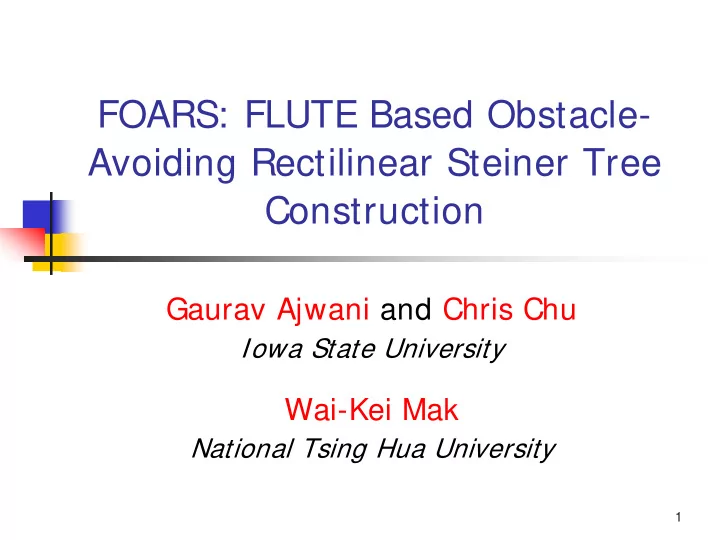

FOARS: FLUTE Based Obstacle- Avoiding Rectilinear Steiner Tree Construction Gaurav Ajwani and Chris Chu Iowa State University Wai-Kei Mak National Tsing Hua University 1
OARSMT Problem Formulation Obstacle-avoiding rectilinear Steiner minimal tree Input A set of pins A set of rectilinear obstacles Output A rectilinear Steiner tree Minimizing total wirelength Connecting all pins Avoiding all obstacles Applications in routing, wirelength estimation, etc. NP-complete More than ten heuristics proposed since 2005 2
Our Contributions An OARSMT algorithm called FOARS (FLUTE Based Obstacle-Avoiding Rectilinear Steiner Tree) Outstanding wirelength Efficient Scalable: O(n log n) time where n = # pins + # obstacle corners New Ideas: Approach to leverage FLUTE for OARSMT construction An efficient obstacle-aware partitioning technique Algorithm to construct obstacle-avoiding spanning graph with good properties 3
If There Is No Obstacle Rectilinear Steiner Minimal Tree (RSMT) problem FLUTE -- Fast LookUp Table Estimation [TCAD 08] Extremely fast and accurate More accurate than BI1S heuristic Almost as fast as minimum spanning tree construction Can we leverage FLUTE for OARSMT construction? 4
Obstacle-Aware FLUTE (OA-FLUTE) // P = set of pins, OB = set of obstacles Function OA-FLUTE(P, OB) T = FLUTE(P) // ignore obstacles If (T overlaps with obstacle) Partition into several sub-problems P 1 ,…,P t T = OA-FLUTE(P 1 , OB) + ... + OA-FLUTE(P t , OB) Return T Two possible types of overlap: 1. An edge is completely blocked by an obstacle 2. A Steiner node is on top of an obstacle 5
Type 1: Edge over Obstacle a b a b Partition pins according to the overlapping edge Include obstacle corners Apply OA-FLUTE recursively on sub-problems to obtain sub-trees Merge sub-trees and exclude corners 6
Type 2: Steiner Node over Obstacle a b a b Partition pins according to the overlapping Steiner node Include obstacle corners Apply OA-FLUTE recursively on sub-problems to obtain sub-trees Merge sub-trees and exclude corners 7
Problems with OA-FLUTE Does not work well if: 1. Routing region is too cluttered by obstacles Reason: Partitioning based on initial tree which ignores obstacles 2. There are too many pins Reason: Performance of FLUTE starts to deteriorate for more than a hundred pins Need a better way to partition the pins Then OA-FLUTE can be called to handle each sub- problem 8
FOARS Overview 1. Partitioning Pins Obstacle-Avoiding Spanning Graph (OASG) Minimum Terminal Spanning Tree (MTST) Obstacle Penalized Minimum Spanning Tree (OPMST) Partition according to OPMST to obtain sub-problems 2. Fixing tree topology and Steiner node locations Applying OA-FLUTE to Sub-problems 3. Routing edges between Steiner nodes / pins Rectilinearize edges to create OARSMT V-shape refinement 9
Connection Graphs To capture the proximity information amongst pins and obstacle corners Previous connection graphs: Escape Graph (Ganley et al. [ISCAS 94]) O(n 2 ) edges Delaunay Triangulation O(n 2 ) edges Obstacle-Avoiding Spanning Graph (OASG) Extension of spanning graph (Zhou et al. [ASPDAC 01]) O(n) edges 10
Problem with Previous OASG Previous OASG Approaches: Shen et al. [ICCD 05] Lin et al. [ISPD 07] Adding “essential edges” O(n 2 ) edges Long et al. [ISPD 08] All considered quadrant partition May not contain RMST even in the absence of obstacle R 3 of C 1,2 R 2 of C 1,2 R 3 of C 1,3 R 2 of C 1,3 R 3 R 2 R 1 of C 1,2 C 1,2 C 1,3 R 4 of C 1,3 R 1 R 4 R 2 of C 1,1 R 3 of C 1,4 C 1,4 C 1,1 R 4 of C 1,1 R 1 of C 1,1 R 4 of C 1,4 R 1 of C 1,4 11
Our OASG Approach Generalization of Zhou’s Approach If no obstacle, same as Zhou’s original algorithm, i.e., presence of RMST guaranteed Octant partition R 8 R 1 R 1 R 8 R 7 R 2 R 2 R 7 R 6 R 6 R 3 R 3 R 6 R 3 R 5 R 4 R 5 R 4 R 4 R 5 O(n) edges 12
OASG Example 13
Minimum Terminal Spanning Tree (MTST) Use the technique proposed by Wu et al. [ACTA INFORMATICA 86] 14
Obstacle Penalized Minimum Spanning Tree MTST OPMST Edge weight = Wirelength considering detour 15
Partitioning Pins OPMST Apply OA-FLUTE to each sub-problem Partition: 1. If an edge is completely blocked by an obstacle 2. If # pins in sub-tree > 20 16
Tree After OA-FLUTE Wirelength 25980 17
Rectilinearization of Slanted Edges Four possible cases for any slanted edge 1.Both L-shape paths are obstacle free 2.Both L-shape paths are blocked by one obstacle 3.One L-shape path is blocked and other is free 4.Both L-shape path are blocked but by different obstacles 18
V-Shape Refinement Replace any two adjacent edges with a Steiner tree Improve wirelength by 1-2% 19
After Rectilinearization & Refinement Wirelength 25290 20
Experimental Results Algorithm implemented in C Comparison with latest binaries from: Lin et al. [ISPD 07] Long et al. [ISPD 08] Li et al. [ICCAD 08] All experiments were performed on a 3GHz AMD Athlon 64 X2 Dual Core Machine (use only 1 core) Four sets of benchmarks, 27 benchmark circuits RC01-RC12: randomly generated by Feng et al. [ISPD 06] RT01-RT05: randomly generated by Lin et al. [ISPD 07] IND1-IND5: Synopsys industrial testcases from Synopsys in Lin et al. [ISPD 07] RL01-RL05: larger testcases randomly generated by Long et al. [ISPD 08] 21
Wirelength and Runtime Comparison Lin et al. Long et al. Li et al. FOARS I SPD 07 I SPD 08 I CCAD 08 Normalized Wirelength 1.023 1.027 0.995 1 Normalized Runtime 78.45 1.20 29.36 1 22
OARSMT for RT10 10 Pins, 500 Obstacles 23
Obstacle-Free Testcase RC03 without obstacles, 50 Pins FOARS Wirelength: 53050 FLUTE-2.5 Wirelength: 53400 24
THANK YOU 25
Recommend
More recommend